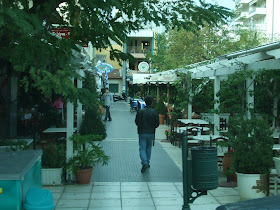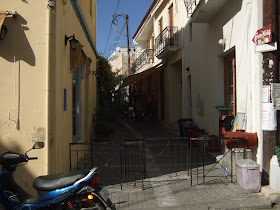My travels
finally took me to Greece, where I'd dreamed of going ever since reading as a child about the myths that described the origins of the world and the lives and adventures of a mind-boggling variety of gods, goddesses, heroes, heroines, and other mythological creatures. As I grew up, I learned that archaeological evidence is a principal source of detail about Greek mythology, with gods and heroes featuring prominently in the decoration of many artifacts. So when an invitation came to go to a conference in Athens, it was as if Kairos himself had come knocking on my door. (Kairos - or Caerus, is the spirit of opportunity, the youngest divine son of Zeus, King of Gods.)
So I read up on my mythology and archaeology, and culture and geography (and thank God for the world wide web!), and armed with renewed knowledge, boarded the flight for Athens.
It turns out that Greece was everything I expected it to be. From the sprawling metropolis of Athens, to the old historic sites of the Ancient Greeks, to the unbelievably blue ocean, to the whitewashed houses of the islands, to the mouthwatering food, to the shops brimming with artefacts, Greece turned out to be my best experience so far.
Athens, the capital of Greece, takes its name from its guardian Goddess Athena. Athena had struck the rock of Acropolis with her spear and caused an olive tree to sprout. The city inhabitants embraced the olive tree as a symbol of peace and prosperity. The sacred rock of Acropolis (well, more like a hill actually) is the symbol of Athens, linking the ancient civilization with the modern city. The monuments date back to the prehistoric era!!
The Parthenon is an arcitechtural masterpiece. It is a Doric temple with 8 columns at the front and 17 on each side. It was dedicated to the Goddess Athena and once housed the golden-ivory statue of the Goddess which was lost during the Byzantine era.
The Temple of Athena Nike was built around 420 BC in commemoration of the victory of the Greeks over the Persians.


The Erechtheion was a temple built during 420-206 BC on the most sacred site in Acropolis, where Goddess Athena's olive tree sprouted. It is built as an assymetrical structure, with the southern balcony of the structure housing the six Caryatids (priestesses who drew their name from the women of Caryes - an ancient city of Arcadia in the Peloponnese) supporting the roof of the structure. I was saddened to learn that all six figures are copies - five of the originals are housed in the Acropolis Museum and the sixth is in the British Museum.


The Theatre of Dionysos - the most ancient theatre in the world, with a seating capacity of 17,000! The original wooden structure had been reconstructed in marble in the 4th century BC. The theatre is still used for performances.
The Temple of Olympian Zeus. Construction started in 515 BC and was completed in 131 AD by Roman Emperor Hadrian. The structure does not have a roof and only 16 of the original 104 columns are left, but it's still huge and impressive.
Following the construction of the Temple of Olympian Zeus in 131 BC, the Athenians built an arch on the northwestern perimeter of the temple to honor the Emperor Hadrian. Hadrian's Arch is the symbolic gate of the city of Athens (my apologies for the poor quality of the photograph).

The Temple of Hephaistos, God of Fire. Built in 460-415 BC on the western perimeter of the Ancient Roman Agora - the commercial hub of the city from the Neolithic Age. I thought this Temple the best preserved of all.
The Library of Hadrian.


The Hellenic Parliament building. Constructed between 1836 and 1842, the building was once the palace of Otto, the first King of Greece. It became the seat of the Greek Parliament in 1934 and houses the first Greek Constitution.

The Zappeion Museum in the National Garden, with its eight Corinthian pillars.

A visit to a Greek island is a must, and so we went to Pireus Port, where we took the ferry boat to the island of Aegina - 30 km from the port and an hour's pleasant sail away.
The blue sea and the white sea gulls made such a beautiful contrast. We were traversing the playground of the rich and famous in their luxury yacths and cruisers.
Sigh!

Our first glimpse of Aegina.
Aegina lies in the Saronic Gulf between Attica and the Peloponnesos. The island takes its name from the nymph Aegina - daughter of the river God Asopus. Aegina was abducted by Zeus, who had taken the form of an eagle, and brought to this island, which then took her name. Aegina gave birth to a son named Aeacus who became King of Aegina. Aeacus was known to have helped Poseidon and Apollo in building the walls of Troy. Through Aeacus, Aegina was the great-grandmother of Achilles (of Troy the movie fame).
Looked at the ruins of the Temple of Apollo.

We debated where to eat, in a cozy street taverna with the blooming bougainvillea or sitting at a sea-front cafe.
The sea-front won, and we had Kalamari and Chiken Shish Kebab with tzatziki sauce. Yummm...
I went a tiny bit overboard buying pistachio, for which the island is famous.
One afternoon we drove along the picturesque coastal road to Cape Sounion, to visit the temple of the Sea God Poseidon. Cape Sounion is 70 km from Athens and the drive took just over an hour.
Ancient cultures in Greece relied heavily on the sea for commercial and spiritual purposes. It would only make sense then that the Greek god of the sea would hold a great deal of respect among ancient Greeks. The Temple of Poseidon has a magnificent view of the Aegean Sea, and has traditionally played the role of the seawatcher, for the return of loved ones, for the safe delivery of goods, for news of war...
The Temple of Poseidon was built atop the ruins of a previous temple in the year 440 BC. The original temple was destroyed by the Persians in 480 BC. TheTemple still retains 16 of the 42 Doric columns. The temple was made of marble found nearby and once housed a large statue of Poseidon in its main hall. The statue of Poseidon is no longer at the temple, it is displayed at the National Archeological Museum in Athens.
We left just as the sun began its slow descent.
As we drove away, I thought of the poem Don Juan by Lord Byron:
Place me on Sunium's marbled steep,
Where nothing, save the waves and I,
May hear our mutual murmurs sweep...
 Okay, enough of theory...let's get down to the real business now: amongst the dishes I had were kalamari...
Okay, enough of theory...let's get down to the real business now: amongst the dishes I had were kalamari...






























































